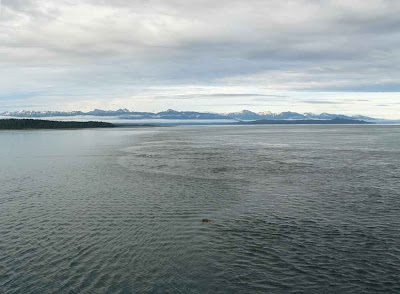7:30 am. Time for first breakfast.
It's raining, and foggy/misty.
There is an orchid on every table in the Lido.

I like the way the light comes in from the back, especially in the lower bits.

Now let's look through that window, instead of it just being backdrop.
Gray, gray, gray, and more gray. We knew to expect overcast and rain, and here they are.

As the clock rolls on, it rains less, gets lighter, and it's somewhat less misty.



The farther we ventured into Glacier Bay National Park, the more the weather cleared.
I don't know if this was coincidence or if it was what usually happens, but when we left that evening it got cloudier and cloudier, as though the park had a special deal with Mama Nature for sunny skies to set off its wonders.....
All of Glacier Bay was full of glacier a mere 250 years ago. The first Europeans to visit this area reported what is now the mouth of the bay to be solid ice. That is an unbelieveable amount of ice ... gone.
There are photographs of the extent of the ice in the late 1800s. So much more than there is now...........
(map of Glacier Bay)




Around this point is ...

Johns Hopkins glacier. We weren't allowed to get too close -- this inlet is a favorite nursery for harbor seals. The seals haul out to give birth, and if startled into the water before they have bonded with their pups, they fail to identify which pup is theirs and the pups starve. Ships must keep out of this inlet until the danger period for seals is past.



We didn't see a lot of critters in Glacier Bay National Park. That is to say -- we saw a lot of critters, but only one sort.

After we left Johns Hopkins glacier, we went to visit Marjerie glacier and the Grand Pacific glacier (close neighbors).
They call it "calving" when hunks of glacier become icebergs, and Marjerie is famous for it. We parked there for a while, and lots of ice fell during our stay.
There is a freshwater river coming out under the glacier, and pouring into the salt water bay. You can see, if you click to enlarge this next pic, the way the gray water is roiling. This churning water brings fish to the surface, which is why there are so many gulls wheeling around.
You can also see, over on the left, hunks of ice that are jussssssst about to fall. Look at the size of the birds -- those are not itty bitty hunks......

This is what it looks like a bit after a sizeable chunk has fallen.....
Some of the pieces that fell while we were there were large enough that the water they displaced rocked the ship. That's pretty big...............

Grand Pacific glacier is a confluence of a bunch of glaciers, and is so big it's hard to wrap your mind around it.
It is, interestingly enough, very much dirtier than Marjerie, and so, they say, is insulated from the sun/heat and doesn't melt/calve at nearly the same rate. This seems counterintuitive, but there it is. The next pic was taken from the same exact location as the previous few, just turning the camera a different direction.


Heading out. This is what the sides of the inlet look like.

That's Grand Pacific directly behind us. Gulls followed us out, as the way the ship moves the water may stir up some fish.

As we ate dinner that evening, the clouds returned.

Look at the water -- something is clearly happening right here, but I don't know what..........

The sunset that night was one of those spectacular ones that no one would believe if you made it up..........



Look at the sharp edge where the clouds begin, and that slice of apparently clear sky just above the water.....

In order to facilitate chronological traverse of these posts, a link to the next one is here.
.

















No comments:
Post a Comment